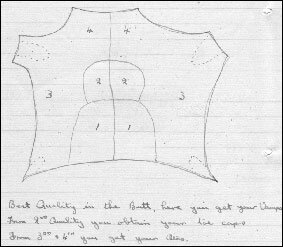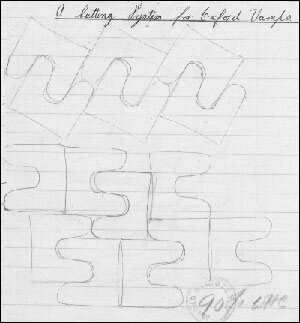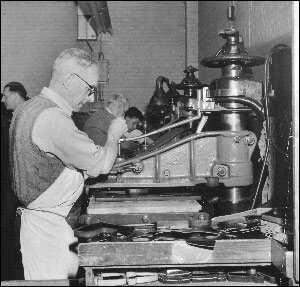Shoes are made up of a number of different pieces of leather or other material sewn or otherwise fastened together and shaped on a last to fit the foot. Clicking is the term for cutting the leather into the pieces required for making the shoes. If the boot or shoe is to fit the last properly then everything must be cut true to the pattern.
 |
|
Drawing showing the correct way to hold the clicking knife
|
|
The knife must be held upright to achieve a good straight edge which can be easily holed or marked and which will keep its shape when it is sewn.
 |
|
A selection of clickers knives from a catalogue of shoe tools
|
|
The most important tools for a clicker are:
-
A good quality knife in order to ensure a good cutting edge and the clicker should make sure he has something to sharpen his knife on
- A good level board which must be cared for by regular oiling and buffing
 |
|
Drawing showing how different quality leather is obtained from different areas of a hide
|
|
The cap of a boot or shoe is usually cut out of the best part of the skin. The front is also cut from the best leather while other parts can be cut from poorer quality skin. Tongues need to be of light, pliable leather.
The clicker needs to have an understanding of the lines of tightness and stretch of a hide in order to cut the material correctly so that the end boot or shoe does not become misshapen.
 |
|
Drawing showing a system for cutting vamps for Oxford shoes
|
|
With a large hide the clicker can work a system for cutting patterns but with a smaller skin he must use his judgement in the pattern layout so they are all cut tight to the toe. Simple rules for systems are:
- Straight lines to straight lines
- Curves to similar curves
Factors that determine the number of times a system can be applied include:
- Size and quality of the skin
- Type of pattern
- Method of application
A good system on one type of leather may not work on another.
 |
|
Picture of a clicking press in operation
|
|
Clicking can also be done by a machine, the clicking press.
There are several advantages to this:
- The outline is cut true to shape
- The edges are square, especially on stout leather
- Operators who are not skilled with the hand knife can cut accurately on the press
- It saves a lot of time
The disadvantages include:
- The cost of the machine and repairs
- The cost of the power to run it
- The cost of the knives and their upkeep
Shoe parts are coloured to show the size of the end shoe. This is usually carried out in the Clicking Room and is done in one of three ways:
- Crayon
- Metal stamp
- Water colour paint
All marks should be made on parts that are lasted in or seamed so they are not visible on the finished shoe.
The colour scheme used is as follows:
Size 6 = yellow
Size 7 = red
Size 8 = white
Size 9 = blue
Size 10 = green
Size 11 = brown
Half sizes are shown either by two colours or two marks of one colour eg two red marks would indicate size 7½.